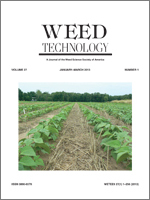Cover crop–based organic rotational no-till soybean production has attracted attention from farmers, researchers, and other agricultural professionals because of the ability of this new system to enhance soil conservation, reduce labor requirements, and decrease diesel fuel use compared to traditional organic production. This system is based on the use of cereal rye cover crops that are mechanically terminated with a roller-crimper to create in situ mulch that suppresses weeds and promotes soybean growth. In this paper, we report experiments that were conducted over the past decade in the eastern region of the United States on cover crop–based organic rotational no-till soybean production, and we outline current management strategies and future research needs. Our research has focused on maximizing cereal rye spring ground cover and biomass because of the crucial role this cover crop plays in weed suppression. Soil fertility and cereal rye sowing and termination timing affect biomass production, and these factors can be manipulated to achieve levels greater than 8,000 kg ha−1, a threshold identified for consistent suppression of annual weeds. Manipulating cereal rye seeding rate and seeding method also influences ground cover and weed suppression. In general, weed suppression is species-specific, with early emerging summer annual weeds (e.g., common ragweed), high weed seed bank densities (e.g. > 10,000 seeds m−2), and perennial weeds (e.g., yellow nutsedge) posing the greatest challenges. Due to the challenges with maximizing cereal rye weed suppression potential, we have also found high-residue cultivation to significantly improve weed control. In addition to cover crop and weed management, we have made progress with planting equipment and planting density for establishing soybean into a thick cover crop residue. Our current and future research will focus on integrated multitactic weed management, cultivar selection, insect pest suppression, and nitrogen management as part of a systems approach to advancing this new production system.
Nomenclature: Common ragweed, Ambrosia artemisiifolia L.; yellow nutsedge, Cyperus esculentus L.; cereal rye, Secale cereale L.; corn, Zea mays L.; soybean, Glycine max (L). Merr.; wheat, Triticum aestivum L.
La producción orgánica de soya en sistemas de rotación con cero labranza basados en cultivos de cobertura, ha atraído la atención de productores, investigadores y otros profesionales agrícolas por la habilidad de este nuevo sistema de mejorar la conservación del suelo, reducir los requerimientos de mano de obra y disminuir el uso de combustible diesel en comparación con la producción orgánica tradicional. Este sistema está basado en el uso de centeno como cultivo de cobertura el cual es terminado mecánicamente con un rodillo de cuchillas para crear una cobertura de residuos in situ que suprime malezas y promueve el crecimiento de la soya. En este artículo, reportamos experimentos que fueron realizados durante la década pasada en la región este de los Estados Unidos sobre la producción orgánica de soya en sistemas de rotación con cero labranza basados en cultivos de cobertura, y delineamos las estrategias actuales de manejo y las necesidades futuras de investigación. Nuestra investigación se ha enfocado en maximizar la cobertura y la biomasa del centeno de primavera debido al papel crucial que este cultivo de cobertura juega en la supresión de malezas. La fertilidad del suelo y el momento de siembra y término del centeno afectan la producción de biomasa, y estos factores pueden ser manipulados para alcanzar niveles mayores a 8,000 kg ha−1





